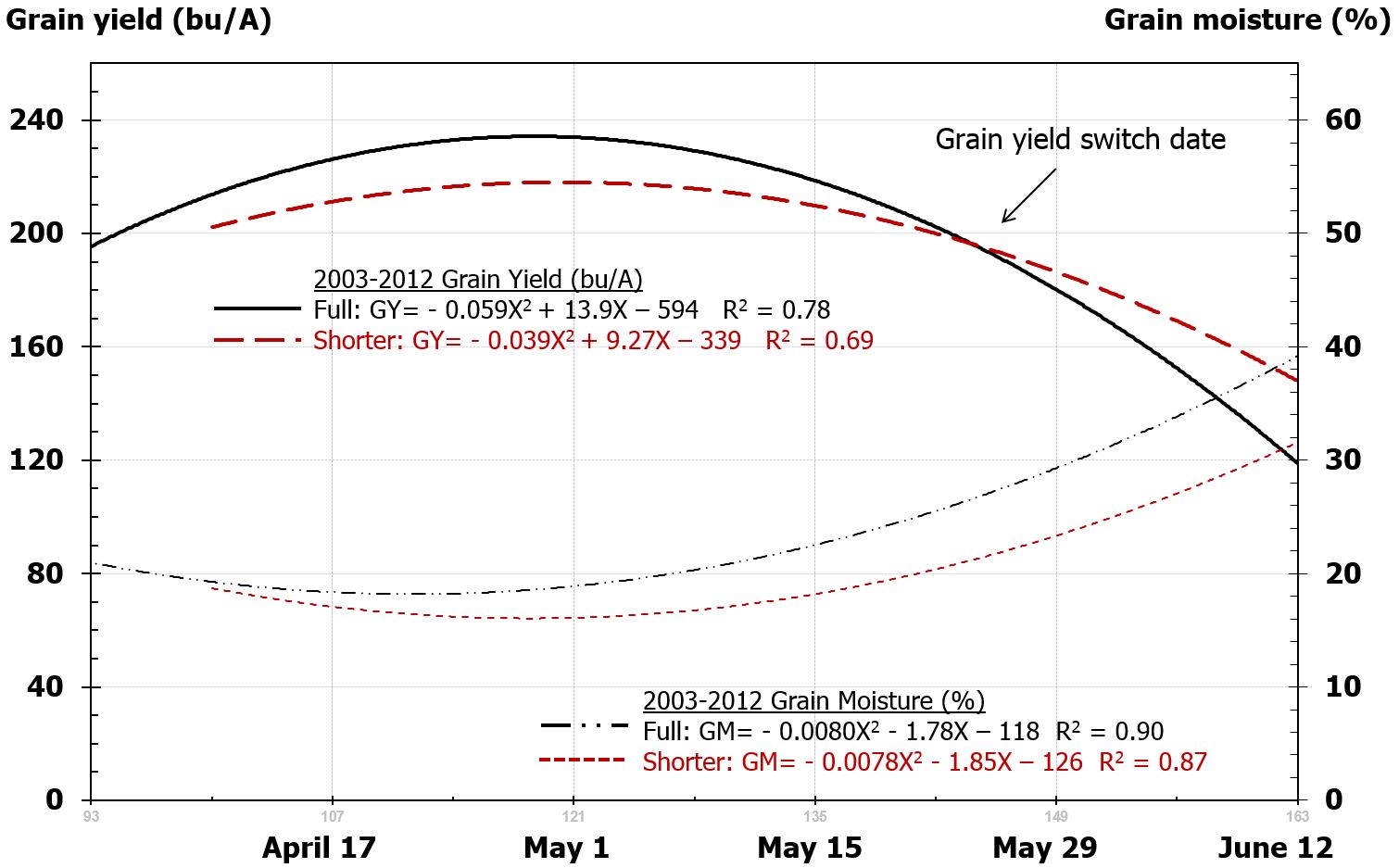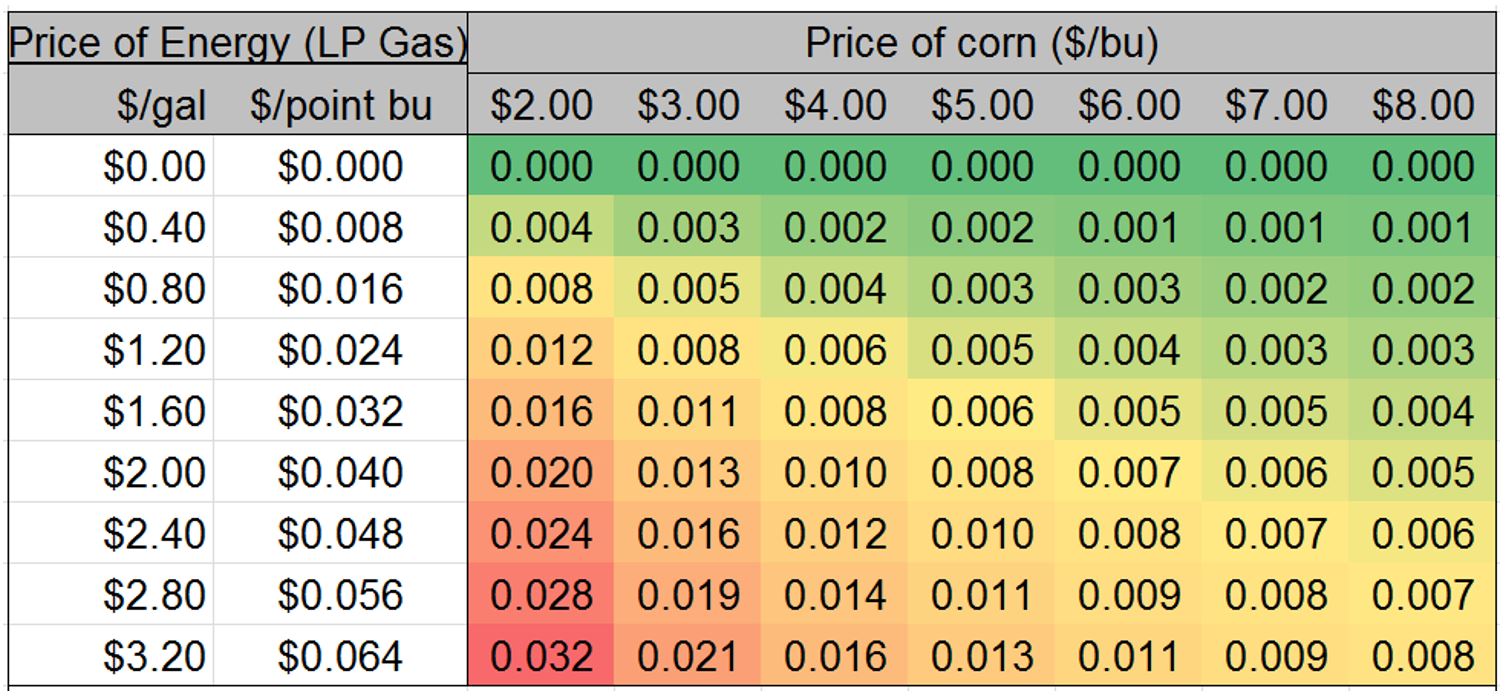| May 15, 2013 |
Field Crops 28.31 - 114
|
|
|
Hitting the Bull's Eye When Switching Corn Hybrid Maturity
Joe Lauer, Corn Agronomist
The 2013 corn growing season is off to its slowest start in a long time. On May 12 USDA-NASS reported 14% of the corn planted. The slowest start ever recorded was in 1984 when by week 19, only 14% of the corn was planted. Other slow starting years (by Week 19) were 1979 (15%), 1981 (20%) and 1993 (21%). Due to the slow start, especially for farmers in northern Wisconsin, many are considering whether they need to switch corn hybrid maturities. In the north, we really only have one opportunity to switch maturity and still have the potential for grain yield. In southern Wisconsin, we may have two opportunities to switch hybrid maturity.
In Wisconsin each Relative Maturity (RM) unit increases grain yield 1.9 bu/A. So farmers often try to select hybrids that are full-season because they offer the best yield potential. The trade-off is that full-season hybrids are often wetter during fall harvest increasing production costs due to higher grain moisture and greater drying/energy cost (Figure 1). On optimal planting dates grain yield of full-season hybrids is usually greater than shorter-season hybrids. However, the rate of yield decline is faster for full-season hybrids, so that by about May 24 the grain yield of shorter season hybrids is then greater than full-season hybrids for planting in late May and early June. What further complicates this management decision is that grain moisture of shorter-season hybrids is nearly always drier than full-season hybrids. Drier grain produced by shorter-season hybrids has implications for production costs of two differentmaturities.
Figure 1. Corn grain yield response of full-season hybrids (104-108 RM) and shorter-season (94-98 d RM) hybrids to planting date during 2003 to 2012 at Arlington, WI (N= 388 plots).

Quite a bit of year-to-year variability can exist on a farm. Table 1 describes maximum yield dates and rate of yield loss for full-season hybridsdescribed previously and includes data for shorter-season hybrids. On average maximum grain yield was about 16 bu/A greater for full-season hybrids. In some years the date when maximum yieldoccursis earlier for shorter-season hybrids, but on average is similarbetween full- (April 28) and shorter-season (April 30) hybrids. Full-season hybrids lose on average about 1.6 bu/A per day in late May compared to only 1.0 bu/A per day for shorter-season hybrids. So when considering grain yield only, the time to switch corn hybrid maturity between full- and shorter-season hybrids ranges between May 1 and June 2 with the average at May 24. In 2009, a very cool year, the shorter
season hybrid alwayshad greater yield thanthe full-season hybrid.
Table 1. Corn grain yield response of full-season hybrids (104-108 d RM) and shorter-season (94-98 d RM) hybrids to planting date during 2003 to 2012 at Arlington, WI (N= 388 plots). In 2012, no shorter-season hybrids were grown.
| |
Full-season
(104-108 d RM)
|
|
Shorter-season
(94-98 d RM)
|
|
| Year
|
Maximum yield (bu/A)
|
Date of Max yield
|
Rate of yield loss May 20
|
|
Maximum yield (bu/A)
|
Date of Max yield
|
Rate of yield loss May 20
|
Grain yield switch date
|
| 2012
|
232
|
May 1
|
1.3
|
|
---
|
---
|
---
|
---
|
| 2011
|
232
|
April 30
|
0.9
|
|
223
|
May 4
|
0.5
|
May 25
|
| 2010
|
267
|
April 29
|
2.3
|
|
240
|
May 5
|
1.0
|
May 21
|
| 2009
|
242
|
April 26
|
1.5
|
|
283
|
April 25
|
1.7
|
---
|
| 2008
|
231
|
May 2
|
1.6
|
|
225
|
May 14
|
0.4
|
May 21
|
| 2007
|
225
|
May 3
|
2.1
|
|
205
|
April 20
|
0.8
|
May 24
|
| 2006
|
238
|
April 29
|
2.3
|
|
237
|
May 2
|
2.1
|
May 1
|
| 2005
|
223
|
April 10
|
0.5
|
|
206
|
May 8
|
0.9
|
May 10
|
| 2004
|
230
|
April 25
|
2.5
|
|
192
|
April 29
|
1.7
|
June 2
|
| 2003
|
223
|
April 29
|
1.2
|
|
191
|
April 17
|
0.4
|
May 31
|
| Average
|
234
|
April 28
|
1.6
|
|
218
|
April 30
|
1.0
|
May 24
|
But grain yield isn't the only factor in this management decision (Table 2). Both grain price and drying costs must also be factored into the economics as described previously. Currently energy costs are about $1.60 to $2.00 per gallon for liquid propane. So if we figure a corn price of $5.00 to $6.00 per bushel, then our hybrid maturity switch date using the above data would be May 17 to May 19. As corn price increasematurityswitch dates become later. Conversely, as drying cost increase maturity switch dates become earlier.
Table 2.Switch dates between full- and shorter-season corn hybrids for various Energy:Corn price ratios. Data includes full-season hybrids (104-108 d RM) and shorter-season (94-98 d RM) hybrids planted on different dates during 2003 to 2012 at Arlington, WI (N= 388 plots).

UWEX recommends the following general guidelines when considering switching corn hybrid maturity. For the next few days, if the weather is good and your fields are fit, proceed with planting the hybrids you have in hand. When using these guidelines, please remember that growing season, site and management influence a particular hybrid's actual days to maturity.
Table 3.Relative maturity of adapted corn hybrids for different planting dates and relative maturity zones. Derived from UWEX A3353 - Corn Replant/Late-Plant Decisions in Wisconsin.

Although the penalty for late planting is important, growers also need to be careful to avoid tillage when soil is too wet. Yields may be reduced somewhat this year, but effects of soil compaction can reduce yields for several years to come. Your decision to switch hybrid maturity depends upon:
- Desire to accept risk: Longer season hybrids offer the highest yield potentials, but may also increase drying costs and/or delay harvest.
- Potential use: For dry grain, relative maturities should be shorter-season within the maturity range for the latest acceptable planting date. For ear corn, high moisture corn, and silage, relative maturities should be longer-season within the maturity range for the latest acceptable planting date.
- Field conditions: Shorter-season hybrids within the maturity range for the latest acceptable planting date should be selected when field conditions include heavy crop residue, reduced tillage, and heavy soil textures.
- Hybrid dry down and grain quality characteristics: Longer-season hybrids within the latest acceptable planting dates should have fast grain dry-down and high test weight characteristics.
- Ease of trading original hybrids for superior shorter-season alternatives.
Literature Cited
Lauer, J. 1997. Corn Replant/Late-Plant Decisions in Wisconsin. UWEX 3353.
Further Reading
http://corn.agronomy.wisc.edu/Management/L010.aspx
Hoeft, R.G., E.D. Nafziger, R.R. Johnson, and S.R. Aldrich. 2000. Modern corn and soybean production. First edition, MCSP Publications, Champaign, IL.
Hellevang and Morey, Energy Conservation and Alternative Sources for Corn Drying. National Corn Handbook - 14.